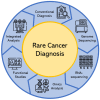An Overview of Advances in Rare Cancer Diagnosis and Treatment
- PMID: 38256274
- PMCID: PMC10815984
- DOI: 10.3390/ijms25021201
An Overview of Advances in Rare Cancer Diagnosis and Treatment
Abstract
Cancer stands as the leading global cause of mortality, with rare cancer comprising 230 distinct subtypes characterized by infrequent incidence. Despite the inherent challenges in addressing the diagnosis and treatment of rare cancers due to their low occurrence rates, several biomedical breakthroughs have led to significant advancement in both areas. This review provides a comprehensive overview of state-of-the-art diagnostic techniques that encompass new-generation sequencing and multi-omics, coupled with the integration of artificial intelligence and machine learning, that have revolutionized rare cancer diagnosis. In addition, this review highlights the latest innovations in rare cancer therapeutic options, comprising immunotherapy, targeted therapy, transplantation, and drug combination therapy, that have undergone clinical trials and significantly contribute to the tumor remission and overall survival of rare cancer patients. In this review, we summarize recent breakthroughs and insights in the understanding of rare cancer pathophysiology, diagnosis, and therapeutic modalities, as well as the challenges faced in the development of rare cancer diagnosis data interpretation and drug development.
Keywords: rare cancer diagnosis; rare cancer treatment; rare cancers.
Conflict of interest statement
The authors declare no conflict of interests.
Figures


Similar articles
-
Multi-omics based artificial intelligence for cancer research.Adv Cancer Res. 2024;163:303-356. doi: 10.1016/bs.acr.2024.06.005. Epub 2024 Jul 9. Adv Cancer Res. 2024. PMID: 39271266 Review.
-
Artificial intelligence for small molecule anticancer drug discovery.Expert Opin Drug Discov. 2024 Aug;19(8):933-948. doi: 10.1080/17460441.2024.2367014. Epub 2024 Jun 18. Expert Opin Drug Discov. 2024. PMID: 39074493 Review.
-
Towards artificial intelligence to multi-omics characterization of tumor heterogeneity in esophageal cancer.Semin Cancer Biol. 2023 Jun;91:35-49. doi: 10.1016/j.semcancer.2023.02.009. Epub 2023 Mar 1. Semin Cancer Biol. 2023. PMID: 36868394 Review.
-
From cancer big data to treatment: Artificial intelligence in cancer research.J Gene Med. 2024 Jan;26(1):e3629. doi: 10.1002/jgm.3629. Epub 2023 Nov 8. J Gene Med. 2024. PMID: 37940369 Review.
-
Artificial intelligence-based multi-omics analysis fuels cancer precision medicine.Semin Cancer Biol. 2023 Jan;88:187-200. doi: 10.1016/j.semcancer.2022.12.009. Epub 2022 Dec 31. Semin Cancer Biol. 2023. PMID: 36596352 Review.
Cited by
-
Multicenter study correlating molecular characteristics and clinical outcomes of cancer cases with patient-derived organoids.J Exp Clin Cancer Res. 2025 Jul 2;44(1):182. doi: 10.1186/s13046-025-03437-0. J Exp Clin Cancer Res. 2025. PMID: 40605011 Free PMC article.
-
Comparing loss of contractual employment pre- and post-diagnosis in patients with rare versus common cancer types: a national registry-based study.J Cancer Surviv. 2025 Jan 6. doi: 10.1007/s11764-024-01726-9. Online ahead of print. J Cancer Surviv. 2025. PMID: 39760980
-
Innovative laboratory techniques shaping cancer diagnosis and treatment in developing countries.Discov Oncol. 2025 Feb 8;16(1):137. doi: 10.1007/s12672-025-01877-w. Discov Oncol. 2025. PMID: 39921787 Free PMC article. Review.
-
iRGD Tumor Penetrating Peptide-Modified NK Cells Exhibit Enhanced Tumor Immune Infiltration Ability and Anti-Tumor Efficacy.Protein Pept Lett. 2025;32(3):183-193. doi: 10.2174/0109298665348639250115113650. Protein Pept Lett. 2025. PMID: 39950266 Free PMC article.
-
Research advances in fungal polysaccharides: production, extraction, characterization, properties, and their multifaceted applications.Front Cell Infect Microbiol. 2025 Jun 9;15:1604184. doi: 10.3389/fcimb.2025.1604184. eCollection 2025. Front Cell Infect Microbiol. 2025. PMID: 40552121 Free PMC article. Review.
References
-
- Gimenez-Lozano C., Paramo-Rodriguez L., Cavero-Carbonell C., Corpas-Burgos F., Lopez-Maside A., Guardiola-Vilarroig S., Zurriaga O. Rare Diseases: Needs and Impact for Patients and Families: A Cross-Sectional Study in the Valencian Region, Spain. Int. J. Environ. Res. Public. Health. 2022;19:10366. doi: 10.3390/ijerph191610366. - DOI - PMC - PubMed
Publication types
MeSH terms
Grants and funding
LinkOut - more resources
Full Text Sources
Medical

